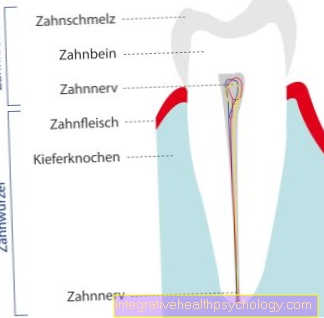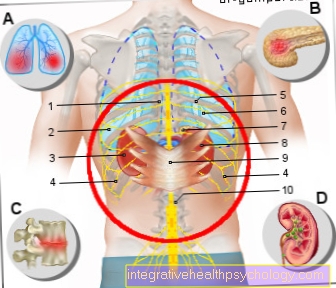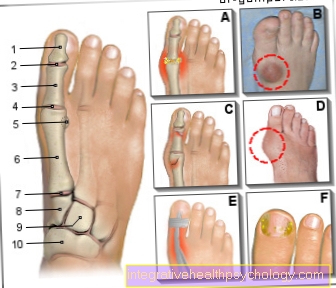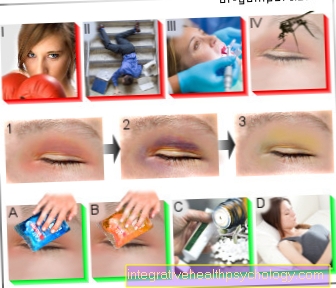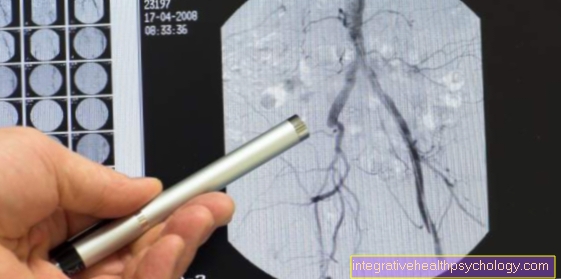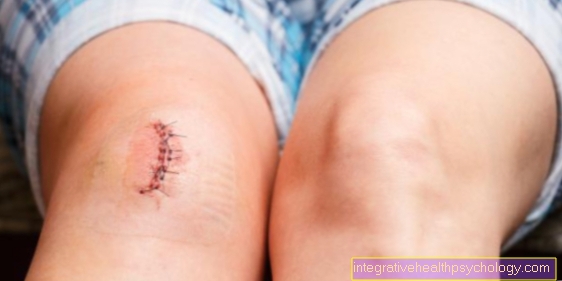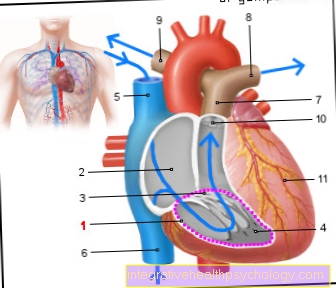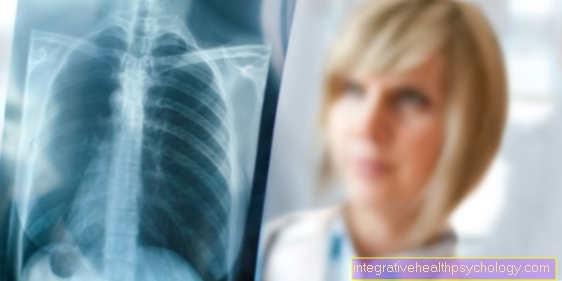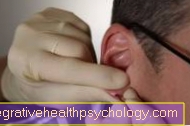What can be the consequences of a tick bite?
introduction
In Germany, two diseases in particular are transmitted through tick bites. On the one hand, borreliosis, which is caused by an infection with the Borrelia burgdorferi bacterium, and, on the other hand, TBE, which is caused by a viral infection. Tick bites often go unnoticed, which is why diagnosis can often be quite difficult.

Overview of the consequences
If ticks are infected with certain viruses or bacteria, they can transmit them to humans. It should be noted that not every tick is infected with one or more pathogens and that these are not transmitted to humans with every bite.
The following diseases are possible after a tick bite in Germany:
Lyme disease
- Joint borreliosis
- Neuroborreliosis
- Acrodermatitis chronica atrophicans Herxheimer
TBE
- Meningitis
- Inflammation of the brain
In other countries, ticks can also transmit other pathogens.
Lyme disease
Borreliosis is the most common tick-borne disease in Germany. It is caused by the Borrelia burgdorferi bacterium. The bacterium can be transmitted through the tick's saliva when a tick bites. It is therefore important to remove a tick as quickly as possible, because the risk of transmission increases with the duration of the bite. Not every tick contains Borrelia. In Germany, depending on the stage of development, between one and twenty percent are infected with the bacterium. The bacteria mainly affect the nervous system, joints and skin.
Read more on the subject at: Lyme disease
An infection with the bacterium usually manifests itself first as a ring-shaped reddening around the tick bite, which occurs a few days to weeks after the bite. It is known as wandering red. This can be accompanied by flu-like symptoms, muscle and joint pain or fever. In ten percent of the cases, the infection manifests itself with neurological symptoms. It is known as early neuroborreliosis. This is often noticeable by an inflammation of the facial nerve, which can manifest itself in facial paralysis. It is noticeable, for example, by a drooping corner of the mouth or a decreased eyelid closure.
If the bacteria attack the spinal nerves of the spinal cord, burning pain occurs, which mainly occurs at night. Often the pain does not improve when taking commercial painkillers, which is why the doctor prescribes special medication for this pain.
Read more on the subject at: Symptoms of borreliosis
Borreliosis is treated with antibiotics (especially doxycycline) for two to three weeks. It is important that the antibiotics are taken regularly over the period so that the disease can completely heal. With adequate treatment, borreliosis usually heals at an early stage without consequences.
Read more on the subject at: Treatment of borreliosis
Joint borreliosis
Joint borreliosis is known as Lyme arthritis. Often it only occurs months to years after infection with Borrelia.
It refers to an intermittent or chronic inflammation of the large joints such as the hips, knees and shoulders, and manifests itself as pain and swelling. In rarer cases, it also affects smaller joints. The inflammation damages the joint cartilage, which is why significant pathological changes in the joints are to be expected in the event of a long-term infection.
Since the symptoms can be very unspecific and often cannot be traced back to a tick bite due to the time lag, a joint effusion is punctured for diagnosis to see whether the genetic material of the Borrelia burgdorferi bacterium can be detected.
The joint borreliosis is treated with the antibiotic doxycycline, which has to be taken in tablet form for two to three weeks. Permanent damage is not to be expected with a prompt diagnosis and adequate treatment with antibiotics.
Neuroborreliosis
A distinction is made between early and late neuroborreliosis in the case of a Borrelia infection. Early neuroborreliosis often manifests itself within a few weeks to months after the bacteria are transmitted through a tick bite. It often manifests itself in the paralysis of a facial nerve, which leads to a drooping corner of the mouth and decreased eyelid closure.
Late neuroborreliosis manifests itself when the Borrelia infection is overlooked for a long time and the infection can develop slowly over months or years. It is very rare. It describes an inflammatory disease of the central nervous system (brain and spinal cord) and manifests itself, for example, in gait and bladder disorders.
It is treated with antibiotics that are given through the veins during an inpatient stay. In the late stage of neuroborreliosis, the disease often does not heal completely and some symptoms can persist.
Read more on the subject at: Neuroborreliosis - What is it?
What consequences can occur on the skin?
After a tick bite, a rash known as wandering redness may develop after a few days. It describes a reddish discoloration of the skin around the tick bite, which slowly fades from the inside out.
Read more on the subject at: Rash after a tick bite
If an infection with the Borrelia burgdorferi bacterium is not adequately treated or if the infection goes unnoticed, long-term skin consequences can occur.
The disease is called acrodermatitis chronica atrophicans Herxheimer. This is a chronic disease that can lead to pronounced tissue atrophy (skin atrophy). The skin feels like cigarette paper. Often there is extensive inflammation on the trunk and extremities before the tissue shrinkage, which appears bluish-reddish. The extensor sides of the legs are particularly affected.
The disease is treated with the administration of antibiotics. If the tissue has already shrunk, the disease will no longer completely heal.
TBE
The disease TBE is known as early summer meningoencephalitis. This is an inflammation of the brain and meninges caused by a viral infection, which can be transmitted by ticks.
Not every tick contains the viruses that cause the TBE disease.Ticks in southern regions are mainly infected. However, the infected ticks are increasingly spreading northwards. Every year around 500 people in Germany develop TBE. The numbers are increasing.
In contrast to Lyme disease, there is a vaccination against TBE. Complete vaccination protection usually exists after three vaccinations, which must be refreshed every three to five years.
The incubation period, i.e. the time from infection with the virus to the first appearance of symptoms, can be several weeks. In the first stage there is a fever, headache and body aches. The symptoms are similar to those of summer flu. In the second stage, inflammation of the meninges (meningitis) leads to a high fever, severe headache and a stiff neck. Furthermore, there may be disorders of consciousness and language, psychological changes or symptoms of paralysis.
The disease cannot be treated with special drugs. The focus is therefore on relieving the symptoms. The symptoms usually heal without consequences.
Read more about the topic at: Early summer meningoencephalitis (TBE)
What diseases can you get infected with?
In Germany you can get infected by a tick bite mainly with pathogens that cause the diseases Lyme disease and TBE.
Around one to twenty percent of ticks in Germany are infected with the Borrelia burgdorferi bacteria. The pathogens are not transmitted with every tick bite. The tick transmits the bacteria through its saliva when it bites. The risk of the bacteria being transmitted increases the longer the bite lasts. It is therefore important to remove a tick early on. Care should be taken to ensure that the tick is completely removed. Infections mainly occur in the summer months. Statistically, one in 100 tick bites leads to infection with Lyme disease. Not every infection triggers symptoms. There is currently no vaccination against the disease.
Around 0.1 to 5% of ticks in risk areas in Germany carry viruses that cause the disease TBE. Not every tick bite transmits the virus. The risk of becoming infected with the virus increases with the duration of a tick bite, as the virus is transmitted via the tick's saliva. It is therefore important to completely remove a tick at an early stage. In addition, symptoms only occur in a third of the transmissions to humans. A vaccination against the disease TBE is possible. After three vaccinations, there is usually complete vaccination protection. The vaccination must be refreshed every three to five years.
Infections with other pathogens are rare in Germany. In other countries in particular, diseases such as babesiosis, ehrlichiosis and rickettsiosis (typhus) can be transmitted.
What consequences can occur after several years?
Long-term consequences can occur, especially in the case of undetected infections with the Borrelia burgdorferi bacterium, which causes the disease borreliosis, or after inadequate antibiotic treatment. These long-term consequences, which often only appear after years, include above all so-called Lyme arthritis, the skin disease acrodermatitis chronica atrophicans Herxheimer and chronic neuroborreliosis.
Lyme arthritis is inflammation of the joints that causes swelling and pain, especially in the large joints such as the hips or knees.
Acrodermatitis chronica atrophicans Herxheimer is a skin disease. This leads to an inflammatory reddening of the skin on the trunk and extremities. If the condition is inadequately treated, tissue atrophy can occur.
Chronic neuroborreliosis occurs in five to ten percent of patients with neuroborreliosis. The progressive inflammation of the brain and spinal cord leads to neurological symptoms such as gait or bladder emptying disorders.
The long-term consequences are all treated with antibiotic and symptomatic therapy.



